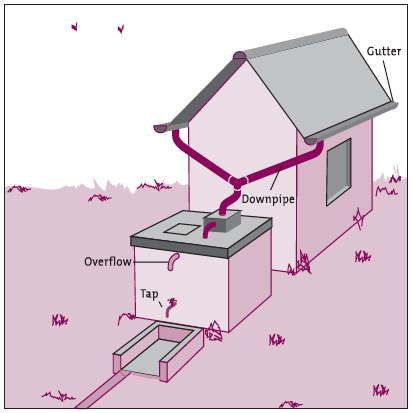वाटर पोर्टल / वर्षाजल संचयन / छत वर्षाजल संचयन
| |
|
|
|
|
|
|
|
|
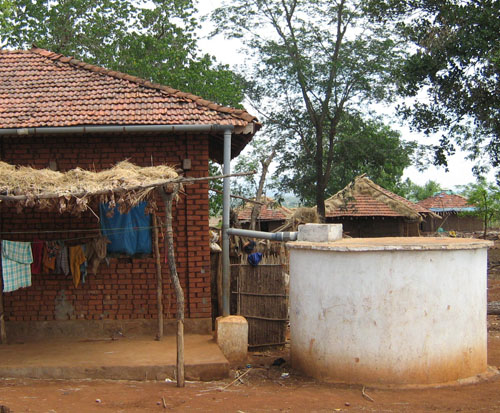
वर्षाजल संचयन का सुझाव घरों और स्कूलों आदि भवनों के लिए दिया जाता हैं, जहां वर्षाजल का संग्रहण जमीन के भीतर या बाहर वाली टंकियों में किया जा सकता है, ताकि बाद में इसका इस्तेमाल किया जा सके. पानी के संग्रह का एक तरीका छत पर वर्षाजल संचयन है, यह किसी भी सुयोग्य छत पर की जा सकती है, फिर चाहे वह- टाइल्स वाले हों, मेटलशीट वाले या प्लास्टिक के, लेकिन यह घास या खजूर के पत्तों वाली छतों पर नहीं किया जा सकता- क्योंकि ये सब वर्षाजल की धारा के लिए अवरोध के रूप में काम करते हैं, गटर और नीचे गिरने वाले पाइप (लकड़ी, बांस, लोहा या पीवीसी बने) के सहारे इन्हें जमा किया जाता है, ताकि घरवालों को उच्च गुणवत्ता वाला पेयजल उपलब्ध हो सके. छत आधारित वर्षाजल संचयन तंत्र के तहत 500 क्यूबिक मीटर वाला भूतल संग्रह टैंक भी हो सकता है, जिसकी मदद से पूरे समुदाय को सहायता उपलब्ध कराई जा सके या एक बाल्टी के जरिये भी हो सकता है जिसे छत के नीचे बिना गटर के सहारे के खड़ा कर दिया गया हो. वर्षाजल संचयन के तंत्र का इस्तेमाल काफी प्राचीन काल से होता रहा है और सभी बड़ी सभ्यताओं में इसके उदाहरण मिलते हैं.
Contents
परिचय
कई मामलों में, भूजल की उपलब्धता पेयजल के रूप में नहीं होती. भूजल काफी गहराई पर उपलब्ध होता है, यह आर्सेनिक या लवण जैसे खनिज और रसायन से प्रदूषित होता है, सतही जल भी विष्ठा या रसायन से दूषित हो सकता है. ऐसे मामलों में वर्षाजल संग्रहण एक प्रभावी और कम लागत वाला समाधान साबित हो सकता है.
वर्षाजल के बारे में सबसे अच्छी बात यह है कि यह आपकी अपनी छत पर गिरता है और लगभग बेहतर गुणवत्ता में उपलब्ध होता है. कई अध्ययनों से जाहिर हुआ है कि ढंग से ढके और देखभाल किये हुए रूफटॉप टैंक का पानी पेयजल की गुणवत्ता के मानकों पर खरा उतरता है. यह घरों, स्कूलों, सामुदायिक भवनों और अस्पतालों को पेयजल और घरेलू इस्तेमाल के लिए तथा दूसरी आय से जुड़ी गतिविधियों के लिए पानी के मामले में सक्षम बनाता है.
यह आपको "बिना चले पानी पाने" की विलासिता उपलब्ध कराता है, पानी ढोकर लाने के परिश्रम से मुक्ति दिलाता है, खास तौर पर महिलाओं और बच्चों को. साफ पानी के 20 लीटर का हर बरतन स्वच्छ जल के निकटवर्ती स्रोत से एक किमी लंबी यात्रा की बचत कर देता है, और खास तौर पर ठंड, भींगे और फिसलन भरे मौसम में इस तरह का काम काफी अरुचिकर होता है, ऐसे में यह छोटी सी मात्रा भी काफी महत्वपूर्ण साबित होती है. युगांडा और श्रीलंका में, वर्षाजल पारंपरिक रूप से पेड़ों, केले के पत्तों और तनों के अस्थायी नलियों से इकट्ठा किया जाता है. यह सुविधा वहां बारिश वाले इलाके के हर घर में उपलब्ध है, फिर चाहे वह पहाड़ की चोटी पर बना हो या समुद्री टापू पर.
दूसरा विकल्प विभिन्न स्रोतों से पानी का इस्तेमाल करना है. पानी चाहे वह खारा हो या आर्सेनिक युक्त उसका इस्तेमाल नहाने-धोने और शौच के लिए आराम से किया जा सकता है. उच्च गुणवत्तायुक्त वर्षाजल को टैंक में सुरक्षित रखकर उसे पीने और खाना पकाने में इस्तेमाल किया जाता है.
सुविधाजनक परिस्थितियां
वर्षाजल संचयन के लिए कम से कम सालाना 100 से 200 मिमी. बारिश की जरूरत होती है. लैटिन अमेरिका के कई इलाकों में हर साल लगभग 500 मिमी. बारिश होती है.
यह तब भी सुविधाजनक होता है जब छतें छोटी हों. उदाहरण के लिए 5X6 मीटर (इसे 30 स्क्वायर मीटर कहा जा सकता है) वाले घर, 500 मिमी. सालाना बारिश के साथ, 15 हजार लीटर पानी प्राप्त करता है, यह मात्रा पांच लोगों के परिवार के लिए पर्याप्त है.
| अनुकूल परिस्थिति | प्रतिकूल परिस्थिति |
|---|---|
| - लगभग हर मौसम में मुमकिन - अगर तंत्र की संरचना ठीक हो और उसका प्रबंधन ठीक से किया जाये तो वर्षाजल सामान्यतः पेयजल की गुणवत्ता वाला होता है. |
- सूखे मौसम में भंडार को ब्रिज करने की जरूरत होती है |
वातावरण के बदलाव का लचीलापन
सुखाड़
सुखाड़ का प्रभाव: जल भंडार का खाली हो जाना.
प्रभाव के अंतर्निहित कारण: बारिश की कमी; निर्माण की गड़बड़ियों की वजह से रिसाव; मांग के अनुरूप भंडार का पर्याप्त न होना – टैंक के काफी महंगे होने के कारण सूखे मौसम में पानी की मात्रा घट जाना.
वाश सिस्टम का लचीलापन बढ़ाना: छोटी टंकियों को बढ़ावा देना क्योंकि वे आसानी से बनाये, ढके और देखभाल किये जा सकते हैं, ये परिवारों के बजट के अनुकूल होते हैं; निर्माण की गड़बड़ी व अन्य कारणों की वजह से होने वाला रिसाव भी इसमें कम होता है; कंक्रटिंग के सही दिशानिर्देश का पालन करना(सीमेंट पर सुखाड़ के प्रभाव को देखें, नीचे); टंकियों का निर्माण कम गुणवत्ता वाली सामग्रियों से करना और बार-बार उसकी मरम्मत कराना; टंकियों की संरचना ऐसी बनवाना कि वह डेड स्टोरेज के लिए कोई जगह न हो; यह सुनिश्चित करना कि जलग्रहण क्षेत्र खुद प्रभावी हो (जैसे नालियां); सूक्ष्म-वित्त तक पहुंच को बेहतर बनाना; सरकार या निजी क्षेत्र की मदद करना ताकि वे टंकी निर्माण योजना के लिए धन उपलब्ध करा सकें.
सीमेंट की टंकियों पर सुखाड़ का प्रभाव
सुखाड़ का प्रभाव: बुरी तरह तैयार कंकरीट और दरारें (उदाहरण के लिए टंकियां, बांध, जलप्रवाह, कुएं और अन्य संरचनाएं).
प्रभाव की मूलभूत वजहें: संसाधन के लिए कम पानी का इस्तेमाल; मिलाने के लिए अशुद्ध पानी का इस्तेमाल.
वाश तंत्र के लचीलेपन को बढ़ाना: समुचित मिश्रण, अनुपात, सामग्रियों की शुद्धता, मिश्रण के लिए न्यूनतम जल को सुनिश्चित करना, समुचित संसाधन उपलब्ध कराना.
सुखाड़ प्रबंधन के लिए अधिक जानकारियां: Resilient WASH systems in drought-prone areas.
सुखाड़ के मद्देनजर सीमेंट का निर्माण: Concrete production and drought.
निर्माण, संचालन एवं रख-रखाव
जलग्रहण एवं भंडारण टंकियां
जल के प्रवाह में रुकावट विभिन्न तरीकों से आ सकती है. जलग्रहण के विभिन्न तरीकों का इस्तेमाल किया जा सकता है, जैसे छत पर जलग्रहण, फर्श पर जलग्रहण, सतह पर जलग्रहण और नदी के बेड पर जलग्रहण. इनमें से सबसे सस्ता भंडारण है धरातल पर भंडार, एक तकनीक जिससे भूजल को रिचार्ज किया जाता है. इसमें वर्षाजल को धरती में प्रवेश कराया जाता है. इससे स्थानीय तौर पर भूजल का स्तर बेहतर हो जाता है और पानी को जब चाहे पंप करके निकाला जा सकता है. इससे पानी का लेबल एक छोटे से इलाके में बढ़ता है या बड़े इलाके में यह मिट्टी की स्थितियों पर निर्भर करता है.
If using storage tanks, structures made with ferrocement or brick-cement are the best and cheapest options, and they can be made locally. When a water tank is below ground, it is called a cistern. Among the different storage types are the underground tank, ferrocement tank, plastic-lined tank, etc. The size of the tank is a compromise between cost, the volume of water used, the length of the dry season, etc. It is advisable to first construct a small tank before attempting a large one. Storage tanks can additionally be filled up using pumps. Several pump systems can be used to lift the water from underground tanks, for example with a rope pump or with a deep well pump, which can elevate water up to a height of 30 m.
Keeping the water clean
Roof rainwater is usually of good quality and does not require treatment before consumption. If the house has a chimney, however, it is possible that the water becomes smoky. High chimneys are therefore preferred. Water is collected through roof gutters made of PVC, bamboo, etc. and stored. The most important thing to ensure water quality is a good lid, keeping out light and insects, and a filter, keeping out all kinds of dirt. A concrete lid protects the tank from pollution. Small fishes can be kept in the tank to keep it free from insects.
A foul-flush device or detachable down-pipe can be fitted that allows the first 20 litres of runoff from a storm to be diverted from the storage tanks. This is because runoff is contaminated with dust, leaves, insects and bird droppings. To prevent the use of dirty water, the runoff is then led through a small filter of gravel, sand and charcoal before entering the storage tank, or a filter is placed between the catchment structure and the storage tank. Where there is no foul-flush device, the user or caretaker has to divert away the first 20 litres at the start of every rainstorm.
The EMAS filtration system
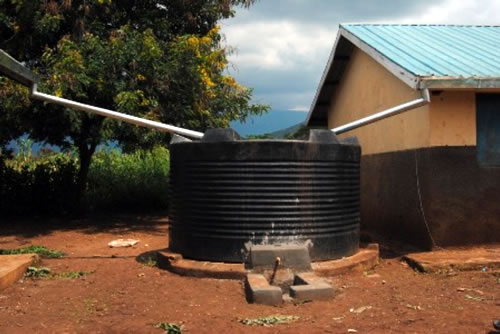
The EMAS system for rainfall collection uses various EMAS technologies as well as simple tools to convert rainwater into usable drinking water. If roof rainwater is being used, it is collected through a regular gutter. To filter the water, at the bottom of the gutter, a pitcher or ferrocement tank is placed, with an outlet pipe. A synthetic cloth bag is attached to the rim of the pitcher using an iron ring or wire, which fits around the edge. The bag should be cleaned every 3 months.
As water begins to collect, to avoid too much garbage collecting here, first some amount of water is deflected, along with most of the garbage. Hereafter, water can be directly sent to an EMAS cistern. It is advisable for multiple cisterns to be available for storage, depending on the size of the roof. Connect one cistern at a time to the outlet pipe. From here water can be pumped and distributed using a regular EMAS pump. The pump can also be connected to faucets and tanks around the house.
Maintenance
The system should be also checked and cleaned after every dry period of more than one month. The outsides of metal tanks may need to be painted about once a year. Leaks have to be repaired throughout the year, especially from leaking tanks and taps, as they present health risks. Chlorination of the water may be necessary.
Removal of debris and overhanging vegetation from gutters and the roof is important to prevent the gutter being clogged. Tank maintenance consists of physical inspection and repairing cracks with cement. Several studies have shown that water from well maintained and covered rooftop tanks generally meets drinking water quality standards if maintained rightfully.
Basic water quality testing is recommended during the first year, with further testing when water quality is in doubt. A low cost water test is the ‘HACH’ test, about US$1 per test. If contamination is suspected or when water quality needs to be guaranteed, the water can be treated in several ways.
Operation and maintenance (O&M) of shared roofs have more challenges. Rooftop-harvesting systems at schools, for instance, may lose water from taps left dripping. Padlocks are often needed to ensure careful control over the water supply. Ideally, one person should be responsible for overseeing the regular cleaning and occasional repair of the system, control of water use, etc. One option is to sell the water, which ensures income for O&M and for organizing water use. Where households have installed a communal system (e.g. where several roofs are connected to one tank), the users may want to establish a water committee to manage O&M activities. The activities may include collecting fees, and controlling the caretaker’s work and the water used by each family. External agents can play a role in the following O&M areas:
— monitoring the condition of the system and the water quality;
— providing access to credit facilities for buying or replacing a system;
— training users/caretakers for management and O&M;
— training local craftsmen to carry out larger repairs.

Potential problems
- corrosion of metal roofs, gutters, etc.;
- the foul-flush diverter fails because maintenance was neglected;
- taps leak at the reservoir and there are problems with the handpumps;
- contamination of uncovered tanks, especially where water is abstracted with a rope and bucket;
- unprotected tanks may provide a breeding place for mosquitoes, which may increase the danger of vector-borne disease;
- system may not fulfill drinking-water needs, during certain periods of the year, making it necessary to develop other sources or to go back to traditional sources temporarily;
- financial investment needed is not affordable - households or communities cannot afford to construct a suitable tank and adequate roofing.
Costs
Comparison of costs
- Brick cement tank of 6 m3: 3 bags of cement, 300 bricks, 3 kg of wire US$ 40
- Brick cement tank of 1 m3: 1 bag of cement, 100 bricks, 1 kg of wire US$ 20
- Plastic-lined tank of 5 m3: US$ 50
- Sub-surface ferro-cement tank of 60 m3: US$ 1,900
The bigger the volume of the storage tank, the lower the material demand (and thus costs) for construction per m3 of tank volume.
In Southern Africa, US$ 320 for a system with 11 m of galvanized iron gutter; a 1.3 m3 galvanized iron tank; downpiping; tap and filters; cost does not include transportation. Where roofs are not suitable for water harvesting, the cost of roof improvement and gutters will have to be added to the cost of a tank. Such costs varied from US$ 4 per m2 (Kenya, subsidized) to US$ 12 per m2. 1
Field experiences
- Rainwater harvesting is a technology which is extremely flexible and adaptable to a wide variety of settings, it is used in the richest and poorest societies on the planet, and in the wettest and driest regions of the world.
- In Ocara, Brazil, rainwater tanks have been constructed of concrete blocks.
- A low-cost option is the brick cement tank, used in for example Nicaragua and Ghana.
Akvo RSR projects
The following projects utilize rooftop rainwater harvesting.
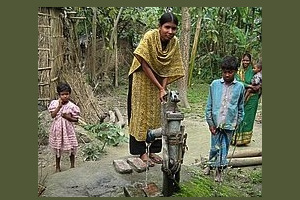 WaSH program in Rural Bangladesh |
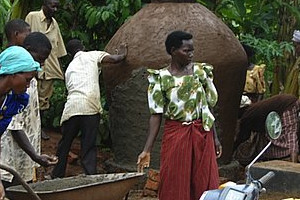 Raising awareness on rainwater harvesting |
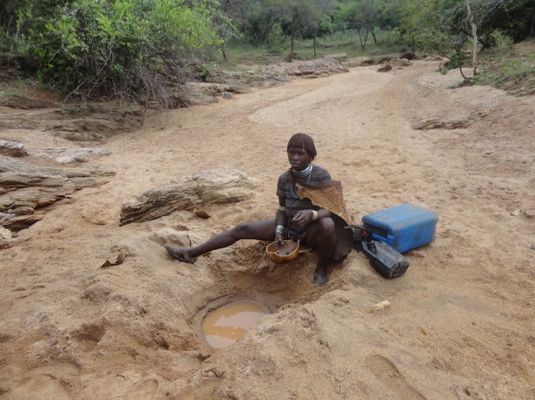 Rainwater for Green Schools Initiative |
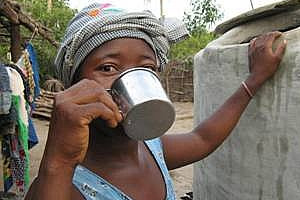 Rainwater harvesting in Guinee Bissau |
Manuals, videos, and links
Manuals
- Download the book "Roofwater Harvesting: A Handbook for Practitioners" from IRC.
- Booklet Smart Water Harvesting Solutions
- Smart 3R Solutions
Videos
by BSP-Nepal |
Harvesting rooftop rainwater |
Pushpam Singh |
Bangalore rural district |
External links
- Rainwater Harvesting Implementation Network (RAIN)
- Rainwater Harvesting information on Practical Action
- Indian website on rainwater harvesting
- Wikipedia article on rainwater harvesting
- Rainwater Harvesting info on the DTU unit of University of Warwick
- Rainwater Partnership
- Catch Water Where It Falls - Toolkit on Urban Rainwater Harvesting
- Akvo solution of the week 5
References
- ↑ 1.0 1.1 Brikke, François, and Bredero, Maarten. Linking technology choice with operation and maintenance in the context of community water supply and sanitation: A reference document for planners and project staff. World Health Organization and IRC Water and Sanitation Centre. Geneva, Switzerland 2003.
Acknowledgements
- Brikke, François, and Bredero, Maarten. Linking technology choice with operation and maintenance in the context of community water supply and sanitation: A reference document for planners and project staff or (alternative link). World Health Organization and IRC Water and Sanitation Centre. Geneva, Switzerland 2003.
- CARE Nederland, Desk Study Resilient WASH systems in drought-prone areas. October 2010.
